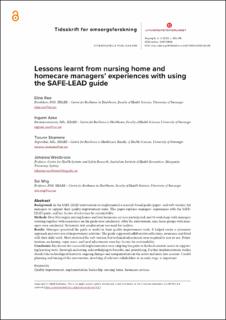| dc.contributor.author | Ree, Eline | |
| dc.contributor.author | Aase, Ingunn | |
| dc.contributor.author | Strømme, Torunn | |
| dc.contributor.author | Westbrook, Johanna | |
| dc.contributor.author | Wiig, Siri | |
| dc.date.accessioned | 2023-02-14T12:03:09Z | |
| dc.date.available | 2023-02-14T12:03:09Z | |
| dc.date.created | 2020-11-21T10:06:23Z | |
| dc.date.issued | 2020 | |
| dc.identifier.citation | Ree, E., Aase, I., Strømme, T., Westbrook, J., & Wiig, S. (2020). Lessons learnt from nursing home and homecare managers’ experiences with using the SAFE-LEAD guide. Tidsskrift for omsorgsforskning, 6(2), 103-118. | en_US |
| dc.identifier.issn | 2387-5976 | |
| dc.identifier.uri | https://hdl.handle.net/11250/3050682 | |
| dc.description.abstract | Background: In the SAFE-LEAD intervention we implemented a research-based guide (paper- and web-version) for managers to support their quality improvement work. This paper explores managers’ experiences with the SAFE-LEAD guide, and key factors of relevance for sustainability.
Methods: Four Norwegian nursing homes and four homecare services participated, and 36 workshops with managers working together with researchers on the guide were conducted. After the intervention, nine focus groups with managers were conducted. Systematic text condensation was used for analysis.
Results: Managers perceived the guide as useful in their quality improvement work. It helped create a systematic approach and overview of improvement activities. The guide supported collaborative reflections, awareness and fitted with their daily work. Most preferred the web-version, but technical adjustments were required to ease its use. Prioritization, anchoring, super users, and local adjustments were key factors for sustainability.
Conclusion: Key factors for successful implementation were adapting the guide to the local context, access to supporting learning tools, thorough anchoring, acknowledging its benefits, and prioritizing. Further implementation studies should take technological maturity, ongoing changes and reorganizations in the sector and units into account. Careful planning and timing of the intervention, involving all relevant stakeholders at an early stage, is important. | en_US |
| dc.language.iso | eng | en_US |
| dc.publisher | Universitetsforlaget | en_US |
| dc.rights | Navngivelse 4.0 Internasjonal | * |
| dc.rights.uri | http://creativecommons.org/licenses/by/4.0/deed.no | * |
| dc.title | Lessons learnt from nursing home and homecare managers’ experiences with using the SAFE-LEAD guide | en_US |
| dc.type | Peer reviewed | en_US |
| dc.type | Journal article | en_US |
| dc.description.version | publishedVersion | en_US |
| dc.rights.holder | The authors | en_US |
| dc.subject.nsi | VDP::Medisinske Fag: 700 | en_US |
| dc.source.pagenumber | 103-118 | en_US |
| dc.source.volume | 6 | en_US |
| dc.source.journal | Tidsskrift for omsorgsforskning | en_US |
| dc.source.issue | 2 | en_US |
| dc.identifier.doi | 10.18261/issn.2387-5984-2020-02-08 | |
| dc.identifier.cristin | 1850612 | |
| dc.relation.project | Norges forskningsråd: 256681 | en_US |
| dc.relation.project | Universitetet i Stavanger: 5091 | en_US |
| cristin.ispublished | true | |
| cristin.fulltext | original | |
| cristin.qualitycode | 1 | |

